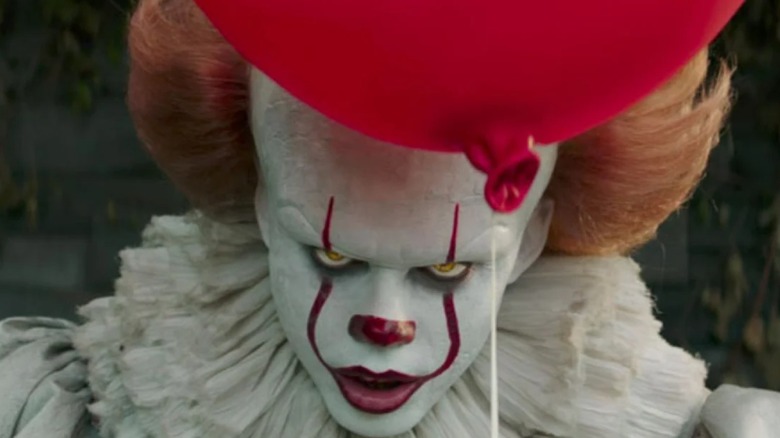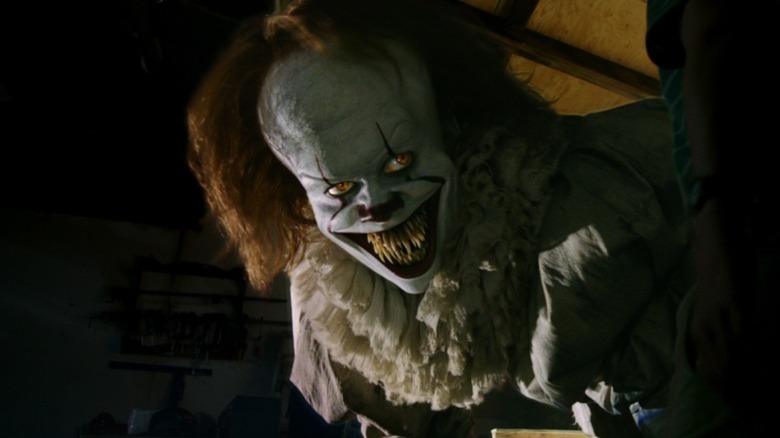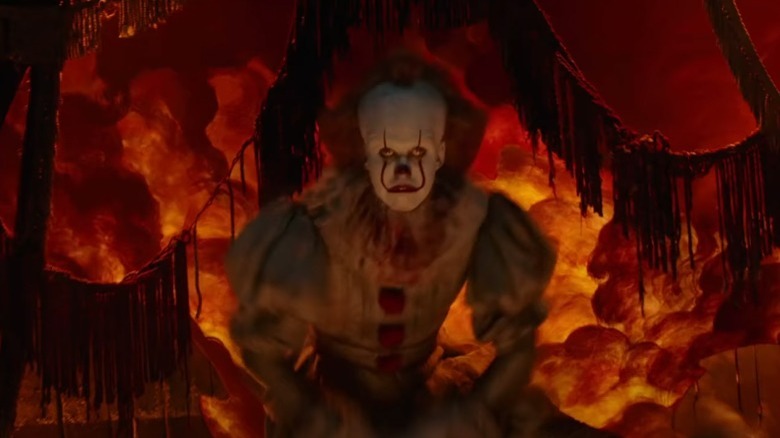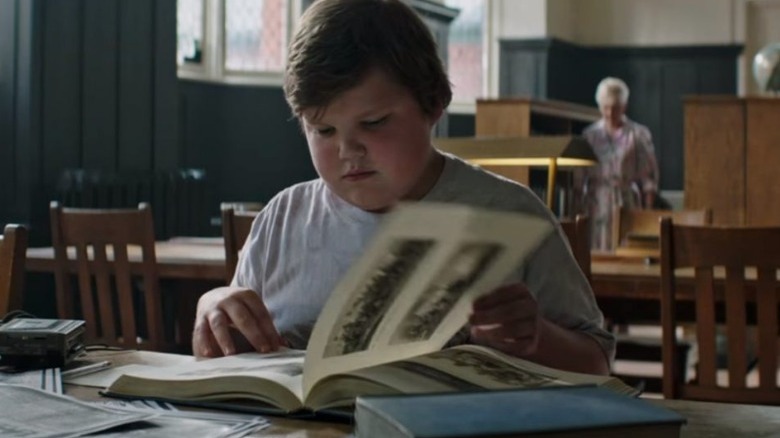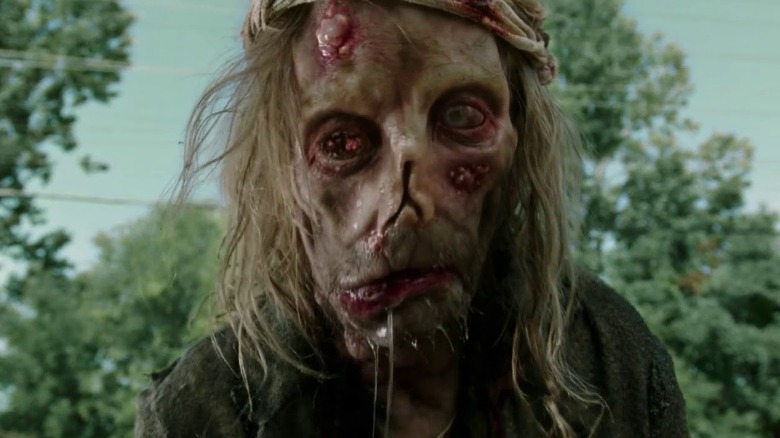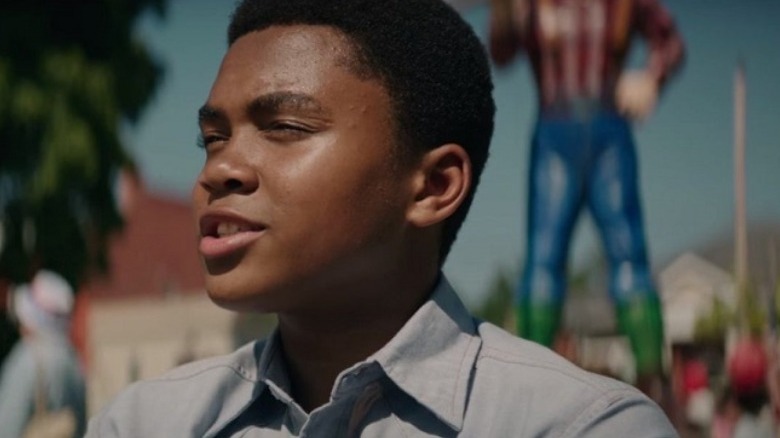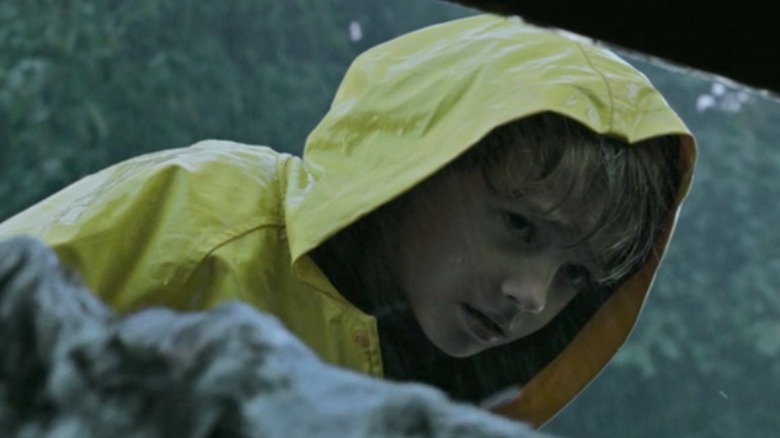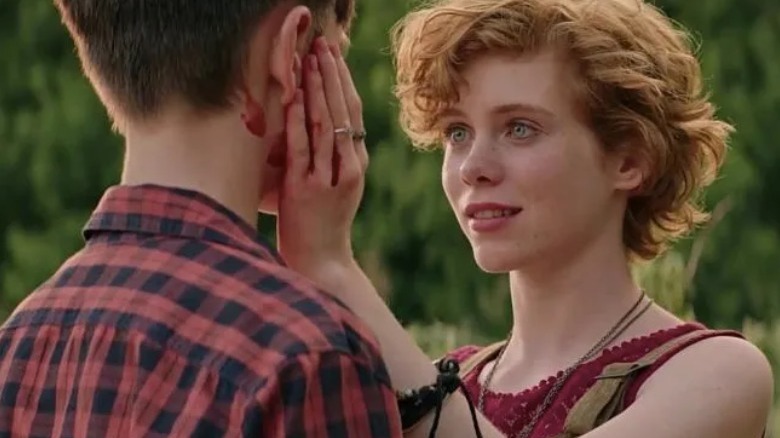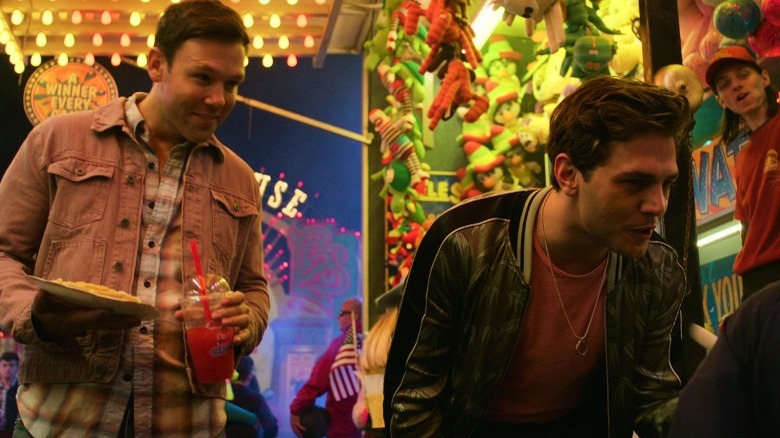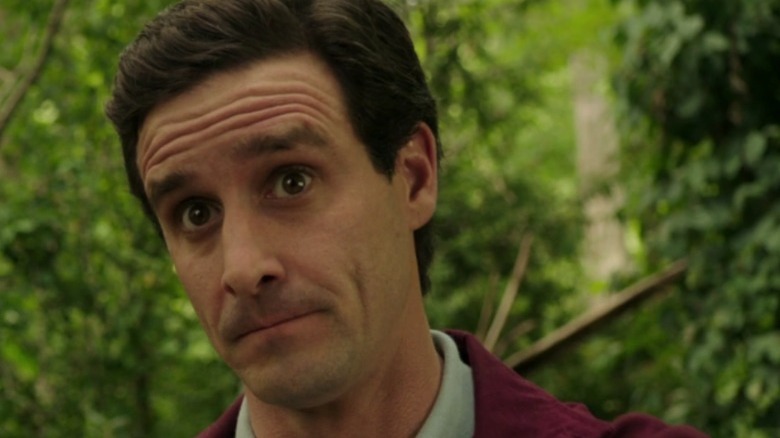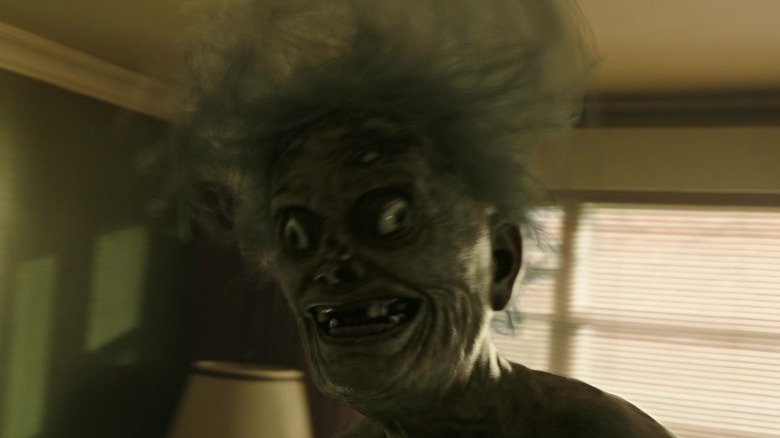It Moments That Really Upset Fans The Most
You know the movie. It's the film that single-handedly made everyone fear ominously lone red balloons. If you didn't suffer from coulrophobia (fear of clowns) before, you might after watching director Andy Muschietti's ("Mama") take on the Steven King horror classic. This movie monster taps into our most primal fears and uses what scares us most to season our meat like salt on steak before moving in for the kill. "It" and "It: Chapter Two" chronicle the story of The Losers Club, (who we'll refer to as "losers" or "the losers" through the rest of this article), a group of misfit preteens who find themselves locked into conflict with a horrific cosmic creature that manifests itself as a terrifying clown. After Bill Denbrough's young brother Georgie goes missing, Bill and his group of friends find themselves in the middle of a nightmarish Summer.
Every 27 years, Pennywise (Bill Skarsgård) the clown comes out to play. It's at these times that the creature must satiate its appetite. It does so by cultivating fear amongst the impressionable youth of Derry before feeding on them. King's book is, perhaps, one of the author's darkest and most controversial works. The novel contains many moments that will never be suitable for a theatrical film and for good reason. Even still, the novel was adapted as a TV miniseries in 1990 starring Tim Curry as the eponymous clown. Then, Muschietti took a stab at recreating the book across two feature films. Since the films obviously made a splash across mainstream media, let's take a look at elements from both movies that drew the ire of fans or absolutely traumatized viewers with fright.
The projector scene
Fans of horror cinema enjoy being chilled to the bone with ghastly and disturbing imagery. But to effectively spook an audience, the filmmakers must ensure that the atmosphere of fear is cultivated with a steady build-up of burgeoning anxiety and dread. A scary visage just popping up out of nowhere isn't legitimately horrifying, it's a cheap jump scare. By the middle of 2017's "It," audiences are fully aware of the horrors that await the group of youngsters who affectionately dubbed themselves The Losers Club. For all they know, they are recounting terrifying hallucinations to one another that may have amounted to simple nightmares or bad dreams.
Eventually, the group of outcasts starts to believe something sinister is afoot and that it's all connected to their little town of Derry. In one horrific scene, they all experience the undeniable terror that is Pennywise when he stalks them and lunges for them out of the projector in Bill's garage. It's a horrifying moment that begins subtly after the projector runs wild with photos and lands on one of Bill's family. Georgie is smiling and his mother's face is covered by her hair in the wind. She morphs into the hideous clown. Many viewers claim this was, perhaps, the single most terrifying moment of the entire film. To put it succinctly, Redditor Vrbtm stated, "Man that project scene f***** me up." We can probably all agree with that sentiment.
Pennywise's dance sequence was humorous
Sure, the story of the horrifying child-eating clown named Pennywise is meant to be terrifying on the surface. After all, Stephen King's novel paints a bleak picture where the cosmic creature's influence is far-reaching even causing the adults of Derry to become jaded and abusive to one another and their children. It's a grim reality that underscores the ultimate struggle the main characters have to endure in their fight with evil. However, the 2017 film wasn't always seen as such a dour and horrifying experience. While the imagery used to terrify the children is often traumatizing, there were often moments of levity mostly thanks to the likes of Richie Tozier (Finn Wolfhard). There's nothing quite like a foul-mouthed wise-cracking adolescent to call it as he sees it.
Richie aside, however, some viewers thought other elements of the film were laughable when they were really meant to be scary. For this reason, some fans were turned off. One such moment comes near the climax of the film when Pennywise is seen doing an odd dance in the sewers. One Redditor found the dance a bit ridiculous noting that it felt "unintentionally comical." Sure, Pennywise, masquerades under the guise of a clown, but that doesn't make him any less prone to dark comedy. Still, some fans thought this moment was simply out of place.
The weird librarian
Not every film is air-tight as far as mistakes or gaffs are concerned. Sometimes, extras do their own thing that doesn't necessarily line up with what's happening elsewhere on screen yet the cut still passes the final edit. Other times, an object or item will appear on camera that wasn't meant to be seen (we're looking at you Game of Thrones). Or maybe, something appears out of place to viewers but is actually entirely intentional by the filmmakers.
One such moment occurs when Ben Hanscom (Jeremy Ray Taylor) is sitting in the library and looking at the history of Derry in books. In the background, a librarian is seemingly organizing books on a shelf. However, as Ben begins to find darker secrets emerge within the books he's reading, the blurry background extra can be seen slowly turning toward Ben. She's even creepily smiling at one point. Redditor Von_Miller wondered if "that was just a bad extra" or if it was, perhaps, intentional. Some didn't notice the woman while others did. But many remarked, believing it to be a creepy detail that simply aided the horrors unfolding in Ben's world. Redditor Harpsidoodle stated, "Scared me more than the projector tbh." Unintentional gaff? Or carefully crafted horror? You decide.
The leper
A horror movie is only as good as its effects. Many films in the genre's storied history resort to practical effects for a more grounded and realistic visual. Films like "The Thing" and "Nightmare on Elm Street" all excelled in the realm of practical effects. "It" made heavy use of CGI. However, some elements were done with make-up and prosthetics including Bill Skarsgård's appearance as the evil clown, Pennywise.
However, one moment that appeared to be a blend of both practical effects and CGI touch-ups came across as silly according to Redditor Wubblz. When young Eddie Kaspbrak (Jack Dylan Grazer) is walking by the derelict and ultra-creepy run-down house on Neibolt Street, he accidentally drops his medicine and scrambles to pick up the pills. Just then a frail hand appears to pick up a pill and it's attached to a horrifically disfigured man with leprosy. Of course, the man is Pennywise. However, the bandaged up man with a rotting face gives chase to Eddie terrifying the young lad. This is a direct reference to a moment that occurred in the novel, though some viewers thought the leper looked more ridiculous than horrific.
Mike is under-utilized
As friends age, they often go their separate ways and embark on their own individual life journeys. That's not always the case, but it's a typical and natural aspect of life. Most might consider Bill Denbrough the very glue that rallies the losers together. However, you'd be mistaken. Mike Hanlon (portrayed as a youth by Chosen Jacobs and as an adult by Isaiah Mustafa in the "It" duology), is actually that person for the determined crew.
In the novel, he provides all of the legwork that sets the stage for the losers' confrontation with Pennywise. He is the historian who learns all about Derry's sordid past and uncovers the sinister appearances of Pennywise throughout multiple generations. When the losers have all but forgotten their traumatizing childhood many years into adulthood, it is Mike that reaches out and brings the crew back together to honor their promise to defeat Pennywise.
In the first of the "It" films from director Andy Muschietti, we witness the losers come together as they are haunted by Pennywise. Many fans of the novel were upset to see that Mike didn't get as much of the spotlight as he should have given his legacy in King's original work. For reasons unknown, the filmmakers positioned Ben Hanscom as the one to reveal the history of Pennywise's influence over Derry instead of Mike. Redditor JaketheSnake54 remarked that Mike was rather forgettable as "he was kinda just there in this movie." While the two films took many cues from King's novel that were overlooked in the 1990 miniseries, they still took some creative liberties that fans weren't entirely pleased with.
Poor Georgie
The most impactful kind of horror comes when innocent youngsters are subjected to terror. Child casualties are simply far more heinous and shocking, and the narrative allows even adults to witness the horror from a child's perspective. "It" does not shy away from targeting young kids. In fact, Pennywise typically satiates its hunger on the flesh of youngsters after the creature has given them a proper scare. That very concept has continued to traumatize fans over poor Georgie's death at the hands of the maniacal clown.
2017's "It" more accurately portrayed Georgie's demise in all of its grisly detail than the 1990 miniseries did. Because of this, the scene does its job well. That job is to make viewers feel something. Hopefully, that something is a mix of dread, horror, and sadness. Some viewers have remarked that they simply can't get over poor Georgie's death. Even after Pennywise grabs the gravely wounded little tyke and drags him into the sewer, everything from that point on is left to the viewers' imaginations. "What messes me up is that is what happened to Georgie," says Redditor tatokd35. "Obviously the poor kid died but we are left to wonder," the Redditor mused. The user's thoughts over the matter linger on whether the boy suffered in death and goes on about how the prospect is both horrifying and sad because these are the very same thoughts that would torment Georgie's older brother, Bill.
Beverly being nabbed by Pennywise
The losers were sure to come to blows with Pennywise in the climactic third act of the 2017 film. The strength of the crew lies in their unity. However, the film depicts the crew angrily disparaging one another and going their separate ways after a major argument. The novel goes to great lengths to depict how the crew prepares for their battle with Pennywise and unifies as a group. It even includes one very unsavory NFSW moment shared between the children upon their attempt to escape the sewers that could not be shown in a live-action film for obvious reasons. However, Beverly is taken by Pennywise and the rest of the losers must confront the evil clown in order to save her.
Beverly's kidnapping never occurred in the book. Therefore, this has brought about interesting arguments among fans. Some suggest that the film simply took the "damsel in distress" route in a fit of sloppy writing. This outdated literary motif obviously wouldn't play well for modern audiences. Redditor Kaloosa even suggested that this plot point was entirely nonsensical given that Pennywise didn't outright kill Beverly like any of the other children despite arguments that stoking her fear makes a "tastier meal" exist. That restraint "seems a little too simplistic," the user states. Another Redditor BearsnLemonCakes, that having Pennywise kidnap "the only female" in the group was rather "tropey."
Even if fear played a role, the Redditor argues that Beverly had overcome her fear of her abusive father making her the strongest in the group capable of withstanding the reach of Pennywise. Any of the other members of the group would've made more sense.
The assault of the couple in the intro of Chapter Two
For obvious reasons, some fans were distraught by the depiction of homophobia manifesting itself violently at the beginning of "It: Chapter Two." The film begins 27 years after the events of the first movie. A man by the name of Adrian Mellon (Xavier Dolan) and his boyfriend, Don Hagarty (Taylor Frey), are enjoying local carnival festivities in Derry when they are accosted by other locals who disparage their sexuality. These locals turn violent and begin to brutally assault the couple even going so far as to toss Adrian over a bridge into the rushing waters of a river below.
After Adrian's boyfriend rushes to his aid below the bridge, he sees Pennywise carrying the injured Adrian and then viciously eating the man's heart in a grisly display. One Redditor acknowledged that the assault was so horrific that they felt physically repulsed. Redditor strengthinlength stated, "All I gotta say is that I fainted in the theater at the start where the couple was being beaten up." Other Redditors discussed negative reactions from audiences towards the scene.
The moment was pulled directly from the novel and was indicative of the level of hatred that courses through Derry thanks to the emerging influence of Pennywise. Given that the future setting in the novel was actual in the 1980s, it also recalls a time when the attitudes toward the LGBTQ+ community were intensely vitriolic. After all, the scene does include an attempted murder as the result of a hate crime that rightfully stirs up natural feelings with real-world parallels all too prevalent.
Eddie's death
When one messes with the forces of an ancient cosmic entity looking out for its own survival, casualties are bound to happen. Aside from the countless children and Henry's bully underlings that became victims of the horrifying clown, the first real casualty of the Losers occurs at the beginning of "It: Chapter Two." Stanley Uris (Andy Bean) receives the fated phone call from Mike Hanlon telling him that "it" has returned and that the crew needs to reassemble. The horrible memories come swirling back and Stanley takes his own life so that he doesn't have to face Pennywise once again.
The rest of the Losers arrive in Derry and spend time refamiliarizing themselves with the town and their old friendships. After finally realizing what truly must be done, they attack Pennywise on his home turf. The creature is far stronger now than before and even manages to deliver a fatal blow to Eddie (now portrayed by James Ransone as an adult) during the struggle. Fans were endeared by Eddie who was a chronic hypochondriac typically afraid of his own shadow. But he musters all the strength he can to combat his worst fears ultimately sacrificing himself for the cause. Richie clearly holds a deep connection with Eddie possibly beyond mere friendship and is completely broken up over the loss.
Redditor Sweetbananagosh commented that Eddie's death and Richie's grief were heartbreaking, saying, "it haunted me for days. I can't believe how sad it was." It is truly an upsetting loss for fans who've intimately come to love and root for these characters and their struggle.
The old lady
As we previously covered, "It" and "It: Chapter Two" made extensive use of CGI for some of the films' most horrific effects. Pennywise's quick transformations would often make use of computer animation. The film, "It: Chapter Two" in particular, has been notably criticized for its lackluster CGI. One of the film's most eerie moments could have seemingly been more horrific if it wasn't bogged down by poor animation effects.
This particular moment is one that was made famous by the film's marketing. When Beverly visits her old home, she finds that her father no longer lives there. Instead, the abode is inhabited by a lone old woman. At first, the lady is warm and inviting, but she steadily becomes more suspicious saying strange things and creepily pausing as she leers at Beverly. It's clear that this is actually Pennywise. Soon the woman emerges from her kitchen naked and grotesquely transformed terrifying Beverly and causing her to flee.
The monstrous version of the old lady has come off as entirely ridiculous to some viewers. This unfortunate reception offsets the incredible, but haunting tone actress Joan Gregson created at the start of the sequence as Mrs. Kersh. Fans were also disappointed at the change that seemed to happen between the point at which the scene was used for a teaser trailer and the final product, changing a practical effect for CGI.
Redditor sumofawitch noted that the CGI was laughable "from Pennywise's crossed eyes to that saggy old lady." Another Redditor (Sage_Is_Singing) shares that the CGI totally turned them off from the experience. The user remarked that "the second Pennywise started turning into a giant old lady" with exaggerated features the film lost their attention.
